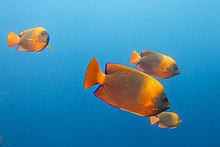| Clarion angelfish | |
|---|---|

| |
| Holacanthus clarionensis | |
| Conservation status | |
 Vulnerable (IUCN 3.1) | |
| CITES Appendix II (CITES) | |
| Scientific classification | |
| Domain: | Eukaryota |
| Kingdom: | Animalia |
| Phylum: | Chordata |
| Class: | Actinopterygii |
| Order: | Acanthuriformes |
| Family: | Pomacanthidae |
| Genus: | Holacanthus |
| Species: | H. clarionensis |
| Binomial name | |
| Holacanthus clarionensis Gilbert, 1891 | |
The Clarion angelfish (Holacanthus clarionensis) is a species of marine ray-finned fish, a marine angelfish belonging to the family Pomacanthidae. It is found in the eastern Pacific Ocean, almost exclusively near islands off the Pacific coast of Mexico.
Description
The Clarion angelfish has a laterally compressed, quadrilateral body. It has a small mouth which is equipped with bristle like teeth. The juveniles have an overall colour of yellowish-orange on the body and fins; the body is marked with a number of blue vertical bars which fade and, eventually, disappear as the fish matures. The juveniles may also have blue lips and blue margins on the dorsal and anal fins. The adults have a brownish face, with the adjacent part of the body behind reddish orange and the posterior body being browner. The dorsal and anal fins are bright orange while the caudal fin is vermilion. The dorsal fin contains 14 spines and 17-19 soft rays while the anal fin has 3 spines and 19-19 soft rays. This species attains a maximum total length of 20 centimetres (7.9 in).
Distribution
The Clarion angelfish has a very limited range in the Eastern Pacific Ocean, being largely restricted to the Revillagigedo Islands of Mexico. Vagrants have occasionally been reported from the southern tip of Baja California and the southeastern part of the Gulf of California, as well as Clipperton Island, a French territory.
Habitat and biology
The Clarion angelfish is found in rocky reefs at depths of up to 30 metres (98 ft). They are typically encountered as either solitary individuals or in shoals. It is a little studied species.
Systematics
The Clarion angelfish was first formally described in 1890 by the American ichthyologist Charles Henry Gilbert (1859-1928), with the type locality given as Clarion, Socorro and San Benedicto Islands in the Revillagigedo Islands, western Mexico. The specific name refers to Clarion Island.
Utilisation
The Clarion angelfish was formerly collected for the aquarium trade, but since the Revillagigedo Islands were declared a protected area collection has been illegal. It has, however, been bred in captivity and captive bred specimens have entered the trade.
References
- ^ Pyle, R.; Myers, R.F.; Rocha, L.A.; Robertson, R. (2010). "Holacanthus clarionensis". IUCN Red List of Threatened Species. 2010: e.T165861A6151012. doi:10.2305/IUCN.UK.2010-4.RLTS.T165861A6151012.en. Retrieved 20 November 2021.
- "Appendices | CITES". cites.org. Retrieved 2022-01-14.
- ^ Froese, Rainer; Pauly, Daniel (eds.). "Holacanthus clarionensis". FishBase. December 2019 version.
- ^ "Clarion Angelfish". Mexican-Fish.com. Retrieved 22 February 2021.
- ^ "Species: Holacanthus clarionensis, Clarion angelfish". Shorefishes of the Greater Caribbean online information. Smithsonian Tropical Research Institute. Retrieved 22 February 2021.
- "Holacanthus clarionensis". Saltcorner!. Bob Goemans. 2012. Retrieved 22 February 2021.
- Eschmeyer, William N.; Fricke, Ron & van der Laan, Richard (eds.). "Species in the genus Holacanthus". Catalog of Fishes. California Academy of Sciences. Retrieved 21 February 2021.
- Christopher Scharpf & Kenneth J. Lazara (21 July 2020). "Order ACANTHURIFORMES (part 1): Families LOBOTIDAE, POMACANTHIDAE, DREPANEIDAE and CHAETODONTIDAE". The ETYFish Project Fish Name Etymology Database. Christopher Scharpf and Kenneth J. Lazara. Retrieved 22 February 2021.
- Jake Adams (20 September 2018). "Captive Bred Clarion Angelfish Coming to LiveAquaria Tomorrow". reef builders.com. Retrieved 22 February 2021.
External links
- Photos of Clarion angelfish on Sealife Collection